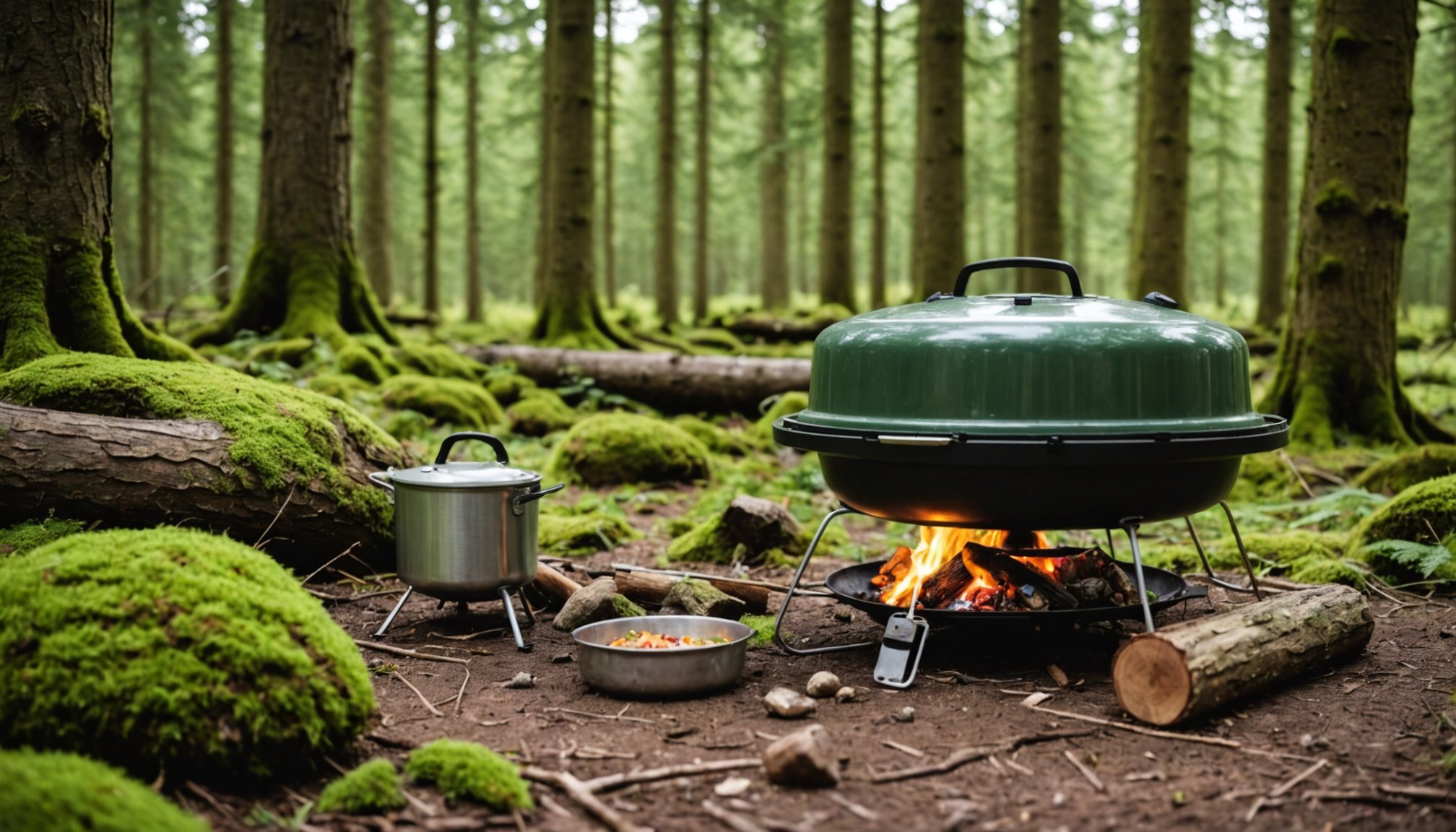Camping in the UK offers incredible experiences, but it also poses challenges, especially when it comes to securing food from wildlife. If you've ever returned to your tent to find your snacks mysteriously vanished, you know the struggle. This guide shares practical tips and innovative strategies to safeguard your camping provisions. Learn how to enjoy nature without the hassle of unwanted animal visitors. Keep your food secure and your adventure enjoyable with our expert insights.
Importance of Food Security in Camping
Ensuring food security while camping is essential for a safe and enjoyable experience. In the wilderness, wildlife threats can pose significant risks to your food supplies. Animals, such as bears and raccoons, are naturally drawn to the scent of food, which can lead to unwanted encounters. Proper food storage and disposal are critical to prevent these wildlife interactions, which can not only spoil your food but also create dangerous situations.
Also to discover : Ultimate Guide to Camping in the UK: Tips for Capturing Stunning Bird Photography
Camping safety relies heavily on maintaining food security. Without it, campers may face health risks from contaminated food or injuries from wildlife. In the UK, prioritising food safety during camping trips is vital due to the diverse wildlife and varying weather conditions that can impact food preservation. By implementing effective food security measures, such as using bear-proof containers or hanging food bags, campers can protect themselves and local wildlife.
The impact of food security on the camping experience cannot be overstated. It contributes to a stress-free adventure, allowing campers to focus on enjoying nature rather than worrying about potential food-related issues. By prioritising food safety, campers can ensure a memorable and secure outdoor experience.
In the same genre : Ultimate Guide to Keeping Your Camping Gear Safe and Secure at UK Festivals
Understanding UK Wildlife
Camping in the UK offers an opportunity to encounter a variety of wildlife. Among the most common animals are foxes, badgers, and deer, each presenting unique behavioral patterns. Foxes, for example, are known for their curiosity and can be attracted to campsites by the scent of food. Understanding these behavioral patterns is crucial for maintaining food security.
Animal behavior around campsites often revolves around their search for food. Foxes and badgers are nocturnal and may visit campsites during the night, while deer might be seen grazing nearby during the day. Recognising these patterns helps campers anticipate and mitigate potential interactions, ensuring a safer camping environment.
Seasonal changes also play a significant role in wildlife activity. During spring and summer, animals are more active due to longer daylight hours and the abundance of food. In contrast, autumn and winter see reduced activity as animals prepare for colder months. Campers should adjust their food security measures accordingly, considering these seasonal variations to protect both their supplies and the camping environment. By understanding UK wildlife and their behaviors, campers can better prepare for a harmonious outdoor experience.
Best Practices for Food Storage
When camping, implementing effective food storage techniques is vital to ensure a safe and enjoyable experience. One of the most recommended camping storage solutions is the use of bear-proof containers. These containers are designed to be resistant to wildlife, providing a secure way to store food and waste. They prevent animals from accessing food supplies, thus reducing the risk of attracting wildlife to your campsite.
Alternatively, campers can use secure food storage methods such as hanging food bags. This technique involves suspending food items from a tree branch, ideally at least 10 feet off the ground and 4 feet away from the trunk. This elevation makes it difficult for animals to reach the food, offering an additional layer of protection.
Moreover, it's crucial to maintain a safe distance between your food storage area and sleeping quarters. Ideally, food should be stored at least 100 feet away from your tent. This distance minimises the chances of wildlife encounters near your sleeping area, enhancing overall campsite safety. By adopting these food storage techniques, campers can enjoy a more secure and peaceful outdoor adventure.
Types of Containers for Food Storage
When camping, choosing the right food containers is crucial for maintaining food security and convenience. Various options are available, each with unique benefits. Plastic containers are lightweight and affordable, making them a popular choice. However, they may not always be the most durable against wildlife. In contrast, metal containers offer superior durability and are less likely to be damaged by animals, though they can be heavier to transport.
Airtight containers are essential for keeping food fresh and preventing odours that attract wildlife. They seal tightly, ensuring that food remains uncontaminated and protected from moisture. Additionally, waterproof containers are beneficial in unpredictable weather, safeguarding contents from rain and damp conditions.
For those seeking space-saving solutions, collapsible containers offer a practical choice. These containers are designed to fold down when not in use, making them easy to pack and transport. Portable food storage options, such as compact, stackable containers, also enhance convenience, allowing campers to organise their supplies efficiently. By selecting the appropriate food containers, campers can enjoy a worry-free outdoor experience, knowing their provisions are secure and well-preserved.
Cooking and Eating Habits to Prevent Wildlife Attraction
When camping, adopting specific cooking methods and meal preparation strategies is crucial to prevent attracting wildlife. Minimising food scents is a fundamental step. Opt for cooking methods that produce less aroma, such as boiling or steaming, instead of frying or grilling, which tend to release stronger scents.
During meal preparation, organise ingredients and utensils to reduce time spent cooking outdoors. This minimises the exposure of food scents to the environment. Consider preparing meals in advance at home, so they require minimal cooking at the campsite. This not only saves time but also reduces the likelihood of attracting animals.
Post-meal clean-up is equally important. Dispose of food waste promptly and store leftovers in airtight containers. Clean all cooking equipment and eating areas thoroughly to eliminate any lingering food odours. Ensure that all food scraps are packed out or disposed of in wildlife-proof bins, if available.
By following these practices, campers can significantly reduce the risk of wildlife attraction, ensuring a safer and more enjoyable outdoor experience. Implementing these strategies helps maintain the natural balance and protect both campers and local wildlife from unnecessary interactions.
Specific Wildlife Considerations in the UK
When camping in the UK, understanding UK wildlife safety is essential due to the unique threats posed by local animals. Specific animal threats like foxes and badgers can present particular challenges. Foxes, with their curiosity, may rummage through campsites, while badgers are known for their strength and persistence when searching for food. Recognising these behaviours is vital for maintaining a safe camping environment.
Regional differences can influence wildlife interactions. In rural areas, deer might be more prevalent, whereas urban fringes may see increased fox activity. This variation requires campers to adapt their camping risks management strategies according to the location. For instance, in areas with high badger populations, securing food in durable containers is crucial.
Legal considerations also play a role in wildlife encounters. In the UK, certain species are protected by law, meaning harming or disturbing them can lead to legal consequences. Campers should be aware of these regulations to ensure responsible and lawful interactions with wildlife. By understanding these specific animal threats and regional differences, campers can better prepare for a safe and respectful outdoor experience.
Potential Risks of Improper Food Handling
Improper food handling during camping can lead to significant food safety risks and increase the likelihood of wildlife encounters. When food is not stored or disposed of correctly, it can attract animals, posing camping hazards. For instance, a camper once left food scraps in an open tent, which drew a curious fox, resulting in damaged equipment and a frightened group.
Health risks are a primary concern when wildlife is attracted to campsites. Animals may carry diseases that can be transmitted to humans through contaminated food or surfaces. Additionally, unexpected wildlife encounters can lead to injuries. A startled badger, for example, might react defensively if it feels threatened by a camper's presence.
Attracting animals can also have broader environmental consequences. Wildlife accustomed to human food may lose their natural foraging habits, leading to dependency and potential harm to local ecosystems. Furthermore, repeated animal visits to campsites can increase the risk of dangerous interactions, both for campers and the animals themselves. By understanding these camping hazards and taking proactive measures, campers can minimise risks and enjoy a safer outdoor experience.
Tools and Gadgets for Food Security
In the realm of camping, food security tools and camping gadgets have become essential for safeguarding provisions against wildlife. These tools not only ensure that food remains uncontaminated but also enhance the overall camping experience.
Among the popular outdoor equipment are bear-proof containers and airtight storage solutions. These gadgets have been highly reviewed for their effectiveness in preventing wildlife access. Bear-proof containers, for instance, are designed to withstand the curiosity and strength of animals like bears and badgers, offering peace of mind to campers.
Recent innovations in camping equipment have introduced products like portable electric coolers and solar-powered food dehydrators. These gadgets provide modern solutions for maintaining food freshness and reducing spoilage. The electric coolers are particularly useful for longer trips, keeping perishable items safe and extending their shelf life.
Moreover, the use of food security tools such as scent-proof bags and portable food lockers can significantly reduce the risk of attracting wildlife. These tools are lightweight and easy to use, making them ideal for both novice and experienced campers. By investing in these camping gadgets, campers can ensure a safer and more enjoyable outdoor adventure.
Case Studies and Anecdotes
Exploring real-life camping experiences can offer valuable insights into effective food security practices. One notable example involves a group camping in the Lake District, who successfully avoided wildlife encounters by meticulously storing food in bear-proof containers. Their experience highlights the importance of using reliable storage solutions to prevent attracting animals.
Personal stories often reveal lessons learned from unexpected wildlife encounters. A camper in Scotland recounted an incident where a fox managed to access poorly stored food, leading to a chaotic night. This encounter emphasised the need for proper food storage and the significance of maintaining a clean campsite to deter wildlife.
Community-shared camping experiences provide practical tips for fellow campers. For instance, a popular suggestion is to prepare meals in advance and store them in airtight containers. This reduces the time spent cooking outdoors, minimising food scents that attract animals. Additionally, campers often share advice on setting up cooking areas away from sleeping quarters to further reduce wildlife risks.
By examining these personal stories and community tips, campers can learn from others' experiences, enhancing their own outdoor adventures with improved food security practices.
Visual Aids and Checklists
In the realm of camping, camping checklists play a pivotal role in ensuring food security and overall preparedness. These checklists serve as practical tools, helping campers systematically organise their supplies and activities. By having a comprehensive list, campers can avoid overlooking critical items that contribute to a safe and enjoyable outdoor experience.
Food storage visuals are equally essential, offering clear guidance on proper storage techniques. These visuals can include diagrams demonstrating how to use bear-proof containers or the correct method for hanging food bags. Such resources are invaluable for both novice and seasoned campers, providing visual cues that enhance understanding and application of safety practices.
Outdoor guides often come with downloadable checklists and visuals, making them accessible resources for campers preparing their trips. These guides can be found in various formats, from printed booklets to digital downloads, catering to different preferences. By utilising these resources, campers can ensure they are well-equipped with the knowledge and tools necessary for maintaining food security in the wild.
Incorporating camping checklists and food storage visuals into trip planning not only promotes safety but also enhances the overall camping experience by reducing stress and uncertainty.










